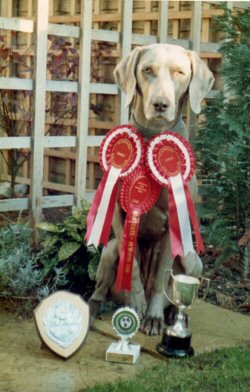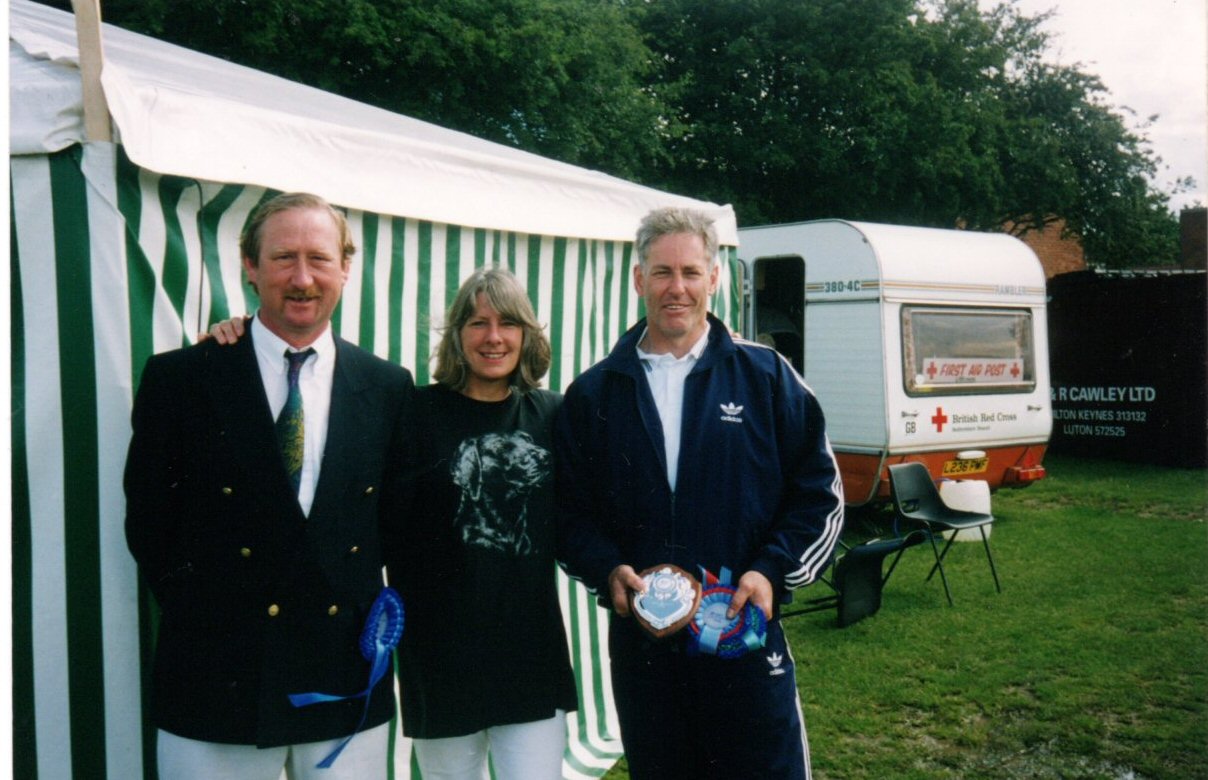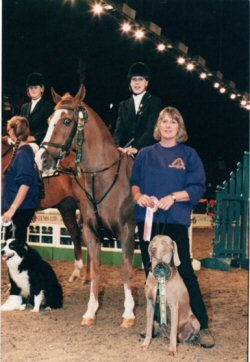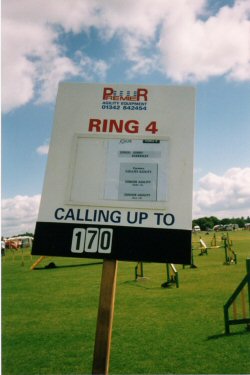|
Co-sponsors of the 2023 Winning Out
Certificates



| |
Competing with a
non-collie breed...
 Has
agility become too complex wondered Sue Knight a little while ago? Like many
others, she came to dogs after many years of horses. She was in the right place
at the right time when she started agility with her Weimaraner, Becky (Beckstone
Game Girl) in the late 1980s. It all seemed less complicated then. Has
agility become too complex wondered Sue Knight a little while ago? Like many
others, she came to dogs after many years of horses. She was in the right place
at the right time when she started agility with her Weimaraner, Becky (Beckstone
Game Girl) in the late 1980s. It all seemed less complicated then.
Those were the
days before ABC classes. In order to join the agility section of my club, we had
to complete an Obedience course. We trained in an indoor riding school with the normal agility and
jumping equipment.
Although Becky did not
have the speed of the collies, she was accurate. As a novice owner, it was a
case of me learning how to handle a very intelligent dog.
I remember one memorable competition night
when she won all her classes
with clear rounds. We were short listed for a Crufts
agility team, but for some reason, the 'collie-owning
committee' did not select us.
When I
started, collie-types were in the majority, and their handlers did seem to me
rather cliquey. They certainly viewed 'other breeds' with suspicion.
Agility seems to be changing constantly
In my day, there was no handling from either side, no
mention of working out stride length for the contact points nor distance of
toy/lead placement. Apparently, the KC Agility Council is now discussing the
introduction of electronic contacts.
As Becky was also a
working gundog, I never used 'tuggy' toys. In
fact, I don't remember them
being used at all,
although some handlers used their rope lead. A small plastic hedgehog was all
that
Becky
needed as reward, retrieved to hand each time,
of course.
Seeing the size of 'tuggies' used for flyball and agility today, I
can't helping thinking of church bell ropes. Can they get any longer or thicker?
Agility was still relatively
new, not coming to Crufts until 1978 when it was just a demonstration to amuse
the audience. The few competitions we entered did not end with success. The
first was my novice handler mistake. Becky completed a line of jumps,
through the tunnel and straight towards my family seated at the ringside.
I cannot remember the venue, but I do remember watching the late Prince Philip
compete in carriage driving so it was not a wasted journey. By now,
we were also competing in Working Trials which featured an agility section of a
three foot clear jump, a nine foot long jump and a six foot scale.
I was
lucky to meet a lady -
also called Sue -
who owned a
border collie named Fern. I
discovered she lived just down the road from me.
She was mainly
interested in working her bitch on sheep but after
talking, she decided to try working trials and agility as well. We
found a field to use within walking distance of home and her husband made a
complete set of working trial equipment plus extra hurdles.
We spent many happy
hours training there. Soon
Sue and her collie started entering agility
competitions. Due to hip problems,
she
had to use a crutch and eventually a
scooter but she still competed by guiding Fern with voice and hand signals.
She was perhaps one of the first handlers to use distance
handling in the ring.
Some
judges were not happy with her use of a stick. The rules
then were not clear on disabled handling and, in
the case of
a
crutch, it was viewed as a training aid. Despite her
disability, Sue went on to qualify in agility and Working Trials which proves
where there's a will there's a way.
 Weimaraner No. 2 Weimaraner No. 2
While
my second Weimie Jessie (Double Dancer UDex) enjoyed club agility, we
concentrated on Working Trials rather than agility competitions.
In 1996, I
entered Jessie in a three
day event at Ardingly Show
Ground which
was run as part of Spillers Festival of
Working Dogs and coincided with a heatwave. Based on horse trials, Day 1
was 'dressage' i.e.
heelwork to a memorised course.
Day 2 was a 2000 metre
cross country course and Day 3 was
'show jumping'. I was
pleased to see three other Weimaraners competing. Unfortunately none of us were
placed, but we were happy with our effort.
By then,
I had a Caranex tent for my weekends away. I seem to
remember they sponsored a class at a large agility show where I gave out the
prizes. Sorry, can't remember where or who these peole were, but the rosette says
Caranex Collies Agility Club Show1998.
 Jessie
and I were selected by our agility club to compete in a Ride & Drive
class at the Horse of the Year Show at Wembley 1998, joining
the team as the non-collie type. Each dog and handler was teamed with a rider.
The course consisted of horse jumps with dog jumps alongside. The rider jumped
the course first, followed by the dog team member. An
equine show jumping course is considerably larger than a canine agility course.
It left me out of breath and with jelly legs, but we completed
it with a creditable sixth place. Jessie
and I were selected by our agility club to compete in a Ride & Drive
class at the Horse of the Year Show at Wembley 1998, joining
the team as the non-collie type. Each dog and handler was teamed with a rider.
The course consisted of horse jumps with dog jumps alongside. The rider jumped
the course first, followed by the dog team member. An
equine show jumping course is considerably larger than a canine agility course.
It left me out of breath and with jelly legs, but we completed
it with a creditable sixth place.
When I joined the Weimaraner
Club of Great Britain in 1985, the emphasis of this versatile breed was on
showing, gundog work and working trials. Agility was regarded as a novelty. Now
celebrating their Platinum Anniversary of 70 years (1953 - 2023) agility is a
main feature of the Weimaraner News, along with showing and field trials/gundog
working tests. Working Trials seem to have slipped out of favour.
While writing on agility,
you do not normally associate Dachshunds with this activity yet many of the
Dachshund Breed clubs held mini agility events and my miniature,
long-haired Dachshund, Prue (Coleacre Carabean)
excelled in competition. She would accompany my Weimaraners to our training
field and had no hesitation in completing a course, although obviously jumps
were lowered.
Dachshunds are hounds, and
as long as they are fit, they are happy to work in the field all day. Prue
also worked with the Weimaraners on the shoot. When they went on point, she
would dive between their legs to flush the game.
My
last visit to Crufts was in 2011 when I made the main arena in the final of the
Gamekeeper classes with my black Labrador retriever. We tried agility in 2013, purely as a fun thing and to keep fit, but I hadn't appreciated
how technical running a course had become and those weaves were still a
challenge.
Now I am enjoying Crufts
from the comfort on my chair. I do
think some of the fun has gone as speed seems to be the determining factor now,
hence the whippet type dogs now in agility and flyball,
but
I have every admiration for
those who compete today, particularly the youngsters.
Long may it continue!
 About the author... About the author...
Sue Knight chose a
Weimaraner as her
first dog because she
knew it was a
versatile sporting dog with clean lines, and she
loved the fact they come in only one colour, silver grey.
In 1984, Becky arrived in
her household in Kent purely as
a pet, but the breeder had stressed how important it was for this breed to have
mental and physical exercise,
so after about a year,
they
enrolled in obedience classes and then to agility.
She found an article
which she had
written in 1989 for the Weimaraner Club of Great Britain entitled
If at first
you don't succeed.. By then they
had tried most canine activities, including
working trials, with limited success. Weimaraners were a rare sight then, apart
from the show ring, and she had comments when booking in such as
'Oh, one of those...
never mind!''
They
persevered, and eventually got
their first red rosettes at club agility and
Sue ended the article
with 'Do not give up, keep trying!'
She felt there was prejudice from breed owners
who worked their dogs on game and regarded agility as 'party tricks' yet, even
dogs on a shoot need to know the command 'over' whether a ditch or fence.
She was
proud to do both.
Pru, a long-haired
miniature dachsund joined the family in early 1990 as companion for
her daughter.
Summer weekends were spent at exemption dog shows. Becky and Pru often won as
Irish Brace! Pru also had obedience and agility training, and both dogs appeared
in film work.
In 1993,
Jessie was her second Weimaraner
and her
'dog in a lifetime' who lived just to please her.
She had already experienced the game
shooting world with Becky and Jessie followed on, including walked up grouse in
the Cairngorms. Qualifying in Working Trials,
and with agility and obedience skills, she too was used in selective filming.
They also qualified for Crufts in both the breed ring and the Gamekeepers class.
Sue's last Weimaraner
in 1998, Georgie, her first male Weimaraner. Moving to Hertfordshire, Jessie and
Georgie were soon living their dream,>
Married to a gamekeeper on a
beautiful estate, they
were able to use their hunt point retrieve skills as well as
obedience and agility.
She
lost Georgie in 2010, shortly after retiring to Suffolk
with Georgie and three black Labradors. All her dogs lived to double figures.
She is left with Drummer, a
12 year black Labrador as
her canine companion, now
retired from the shooting field.
For almost
40 years,
Sue has
been lucky to combine secretarial work with
writing, photography and dog training.
First
published 14th May 2023 | |
|